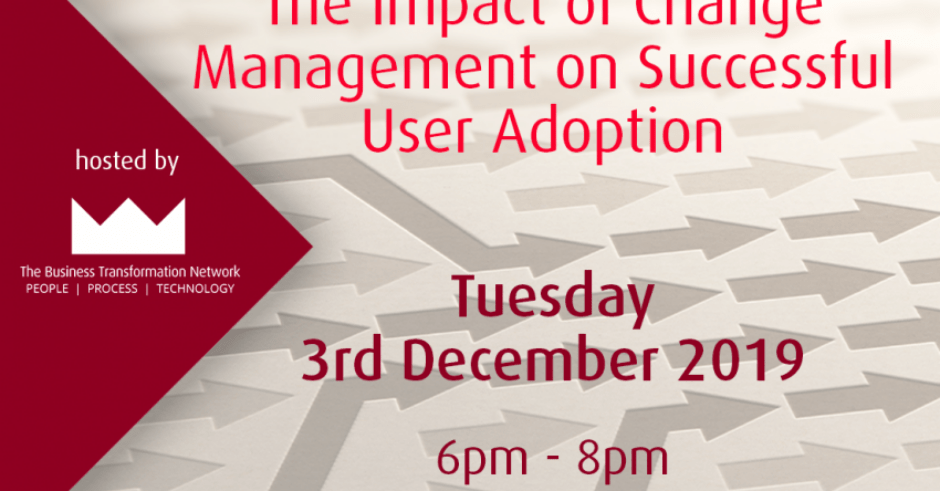The Business Transformation Network recently hosted an event on “The Impact of Change Management on Successful User Adoption”, at the Bloomsbury Hotel in London.
The conversation was open and varied, touching on a wide variety of subtopics under the enormous initial question including:
1. Where should communication sit within change management?
2. How do you measure the monetary value of change management? Is success the value-added?
3. Can you prove the overall value of change management to a business?
4. How can you ensure lasting change?
User adoption rates for change and transformations within organisations are often low, predominantly because user’s don’t have enough of an understanding of what’s changing to be fully invested in the change process and it’s lasting adoption. The key to long-term success when conducting change is realising that there’s a process for change management, and that approaching it in a thought out, intentional way can improve results.
When conducting change, organisations need to get their ‘front-line’ on board, as well as the senior management team. To get employees on board they need to fully understand why the initiative is being taken.
From this starting point, the initial discussion revolved around communications during times of change, focusing on where it should sit and how organisations can go about it.
When conducting change, organisations often struggle with obstacles in the form of people rejecting change and communications can be the key to whether the change succeeds or not. Communication is undoubtedly a huge part of change management, but the argument often falls down to where it sits: Whether it is part of a separate function, or part of the wider change team?
It was agreed that there is an enormous difference between corporate and project communications which should be managed accordingly, with the two areas working as a partnership to create a common, clear communications thread for the people. When looking at change communications, there is a distinct split between content and control: Content needs to be absolutely aligned to the message, but control is to ensure that it happens.
The discussion developed into looking at how communications can’t be kept separate from the change project, as alignment is integral for getting the ‘front-line’ on board. The ownership of communications should always sit with comms, but should be managed by change, who are the experts about what they want to say and comms can help them work out how to get the necessary information across in the best way possible.
The attendees used an analogy for communications, especially during times of change as being like ‘Air Traffic Control’, emphasising that just because the ‘flight’ has left your airspace, it doesn’t mean that it’s not still in your wider area – You still need a general understanding of what is going on with it, that needs communicating if anything changes.
This developed to highlight how integral it is to both know your network and understand what is happening, as if you don’t understand, then others won’t ‘get it’ and the right message cannot be communicated properly.
The conversation then progressed to looking at how you can measure the value of change management, considering whether it was monetary value or, if it was all about the value added?
This caused a divide amongst attendees with the conversation taking two predominant routes.
One part looked at the intangible value adds of change within an organisation, focusing on the cultural and sustained organisation wide differences as a result of change, that are the difference between survival and the potential of complete failure, cementing the ‘if we don’t change, we lose’ mindset as a driver for change. The progression of this part of the argument was looking at the cost of not changing and the risk associated with this and then work forward from here to understand the true value a change can present to an organisation.
The other side of the argument focused on how in some industries the sole purpose for change is financially driven, with a predominant focus on cutting costs. Businesses in the current working environment are focusing on the fiscal aspects as a priority, creating more tactical plans and changes.
To conclude the conversation, we looked the impact senior level buy-in to change can have, this was agreed to be predominantly due to strategy being a top-down action, but change tends to function in a bottom-up capacity, meaning that you need senior leaders on board as well as SME’s at ‘ground level’. From this approach, comms needs to be used as a continuation of support for employees, acting as a ‘we’re here and still listening’ post implementation.
In short, the main point of change is for it to become BAU, meaning the change is well integrate and sustained and this is a result of open communication, backing and high-level support. As the new normal, change is always going to be around and employees need to understand the reason it is needed and be able to adapt, in order for our current organisations to succeed long-term.

